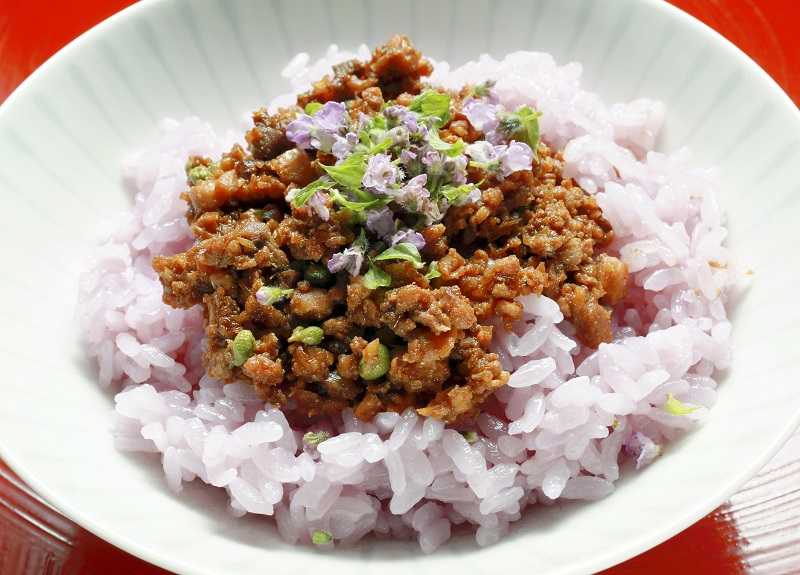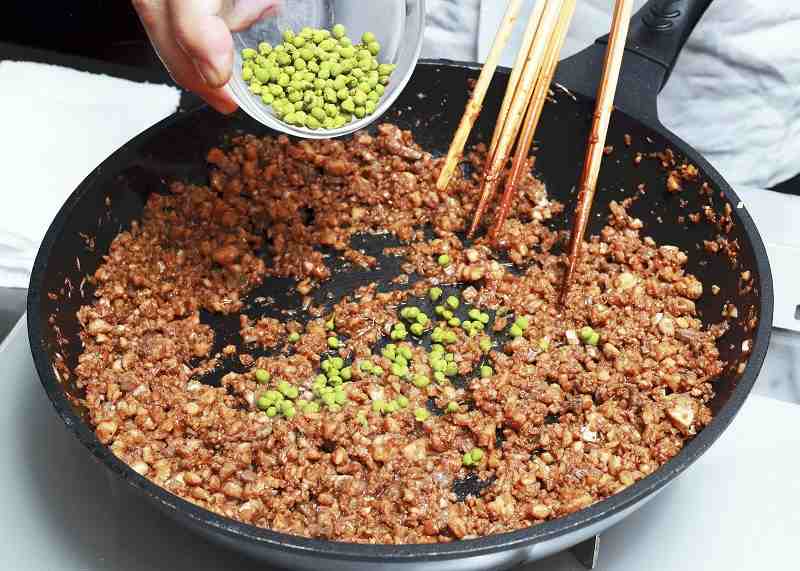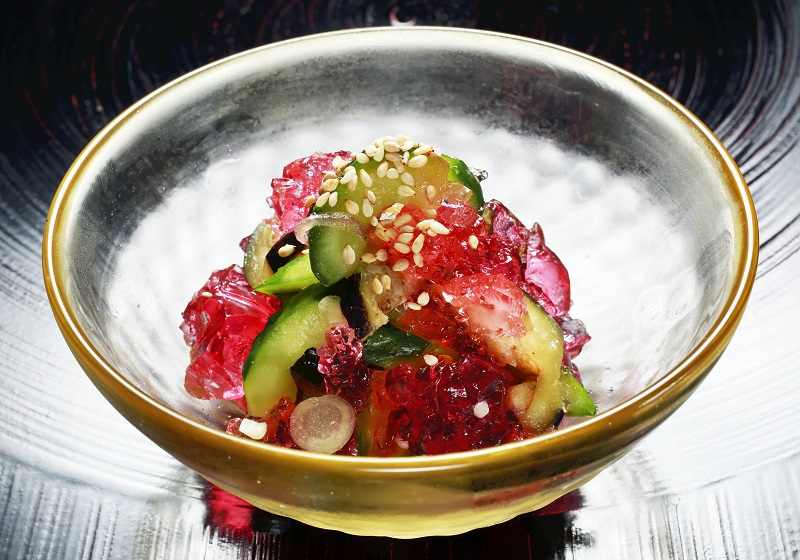
Rice cooked with a decoction of red shiso leaves and topped with soboro
12:00 JST, August 13, 2022
If you’re looking for a refreshing and tangy summer dish, Japanese cooking specialist Takamitsu Aihara recommends rice cooked with a decoction of red shiso leaves. The rice, which has a tantalizing pale purple color, goes well with soboro seasoned ground fish and sansho peppercorns. For the soboro, Aihara uses aji horse mackerel, which is currently in season.
“It’s the perfect time to enjoy the color and aroma of red shiso leaves,” Aihara said. “Unlike general shiso leaves, which are available all year round, red shiso leaves are seasonal.”
To cook the dish, he first boiled a pot of water and added plenty of the fragrant leaves. The decoction initially turned a bluish-purple hue, but when Aihara added vinegar, it suddenly transformed into a bright reddish-purple color. “Vinegar does the job,” he said. This change is similar to when lemon juice is added when making red shiso leaf juice. It was fun to watch, and felt akin to a small-scale chemistry experiment.
Aihara explained that the vinegar stops the rice from going bad, “which makes it a great choice for lunch boxes, too.”
While waiting for the rice to be cooked, he prepared the aji soboro. Holding multiple kitchen chopsticks in one hand, he crumbled and seasoned the fish, frying it as he did so until the fish released its water — and shortly afterward, the fish oil began releasing a savory aroma.
Aihara served the shiny, pale purple rice — with a slight aroma of shiso and vinegar — in a rice bowl and topped it with soboro mixed with sansho peppercorns. Finally, he topped the dish with shiso flowers. “Seasonal ingredients are good for your body,” he said with a smile.
The refreshing taste of the rice is complemented by the tang of the sansho peppercorns, while the aroma of the shiso leaves can be further enhanced by mixing the flowers into the rice. This distinctively flavored dish is a great choice to pep you up in the summer heat.
Rice with red shiso leaves
Ingredients (serves 4):
- 2 cups rice
- 50 grams red shiso leaves
- 10 ml vinegar
- 200 grams aji horse mackerel
- 30 grams ginger
- 30 grams green onion
- 2 tbsp sansho peppercorns
- 2 tbsp soy sauce
- 2 tbsp sake
- 1 tbsp red miso
- 1 tbsp sugar
- ½ tbsp oil
- Shiso flowers as desired
Directions:
1. Wash rice, leave for 30 minutes and drain.
2. Pour 550 milliliters of water into a pot and bring to a boil. Add red shiso leaves and simmer for 2 to 3 minutes over high heat. Add vinegar and strain the liquid after the color changes. Chill in the refrigerator.
3. Put rice in a rice cooker or a donabe clay pot. Add decoction and cook as per usual.
4. Remove sansho peppercorn stems, then boil the peppercorns in 300 milliliters of water to remove pungency.
5. Wash aji and cut into fillets. Remove skin and cut into small pieces. Place in a bowl and add soy sauce, sake, red miso and sugar. Mix well.
6. Chop green onion and ginger.
7. Heat a pan and stir-fry green onion and ginger with oil. Once fragrant, add fish mixture and seasoning to make soboro. Add sansho peppercorns when the fish releases its oil. Remove from heat.

Sansho peppercorns are added to a pan as the fish oil starts to give off a savory aroma.
8. Put rice in a rice bowl and top with soboro and shiso flowers.
Soy sauce-like seasoning

Asazuke light pickles are served with red shiso leaf jelly.
Aihara also shared his recipe for asazuke light pickles with red shiso leaf jelly, which can be used to season food a la soy sauce.
First, dissolve 8 grams of gelatin powder in cold water. Prepare a pan and add 200 milliliters of water, 100 milliliters of vinegar, 20 grams of red shiso leaves, 30 grams of superfine sugar, 3 grams of salt and a dash of light soy sauce. Heat, and remove the leaves when the liquid turns reddish-purple. Add the gelatin to the pan, turn off the heat and refrigerate the resulting mixture. Combining lightly pickled cucumber and eggplant with the jelly makes for a sweet and salty taste.
"Features" POPULAR ARTICLE
-

Sanrio to Open Museum in Yamanashi Pref. Dedicated to Founder, Exhibits Include Hello Kitty, Other Characters
-

Autumn Foliage Surrounds Visitors to Tokyo’s Showa Kinen Park
-

My Daughter No Longer Speaks to Me, But I Want to See Her and My Grandchild
-

Kumamoto: Public Bath Refurbished as Library Where You Can Chat, Take Photos
-

Frozen Vegetables: Demand Rises for Convenient, Tasty Domestic Produce
JN ACCESS RANKING
-

Tokyo Economic Security Forum to Hold Inaugural Meeting Amid Tense Global Environment
-

Keidanren Chairman Yoshinobu Tsutsui Visits Kashiwazaki-Kariwa Nuclear Power Plant; Inspects New Emergency Safety System
-

Imports of Rare Earths from China Facing Delays, May Be Caused by Deterioration of Japan-China Relations
-

University of Tokyo Professor Discusses Japanese Economic Security in Interview Ahead of Forum
-

Japan Pulls out of Vietnam Nuclear Project, Complicating Hanoi’s Power Plans


























